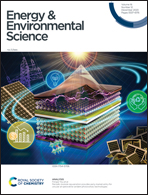Realizing an excellent conversion efficiency of 14.5% in the Mg3Sb2/GeTe-based thermoelectric module for waste heat recovery†
Abstract
Mg3Sb2-based thermoelectric materials are drawing significant attention due to their earth-abundant elements and multiple conduction band structures. Alloying Mg3Bi2 in Mg3Sb2 can regulate the band structure and phonon scattering, but uncoordinated bipolar conduction poses a barrier to performance enhancement across wide temperature ranges. Herein, augmented zTs of ∼0.5 at room temperature and ∼1.7 at 673 K were obtained in Mg3.2Sb1.24Bi0.75Se0.01 due to its high average quality factor contributed by the improved weighted mobility and the suppressed bipolar thermal conductivity. Moreover, the transition metal (Co) is introduced to modify the carrier scattering mechanism, which further enhances the room-temperature zT to ∼0.7 and average zT to ∼1.43 from 300 K to 773 K in Mg3.15Co0.05Sb1.24Bi0.75Se0.01. Together with the excellent p-type (Pb0.15Ge0.85Te)0.8(AgSbTe2)0.2 developed in our previous work, we realized a record-high single-stage module-level conversion efficiency of ∼14.5% at a temperature difference of 480 K, signaling a promising future for Mg3Sb2-based thermoelectric materials in intermediate waste heat recovery applications.



 Please wait while we load your content...
Please wait while we load your content...